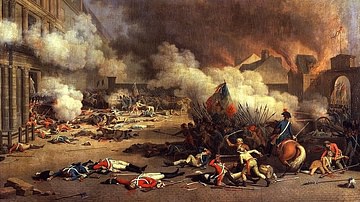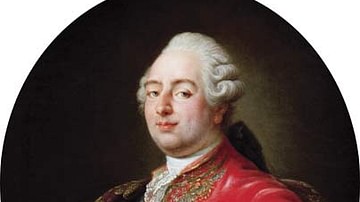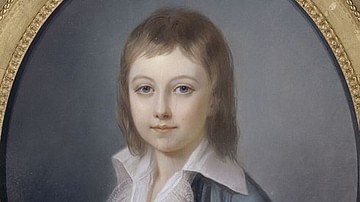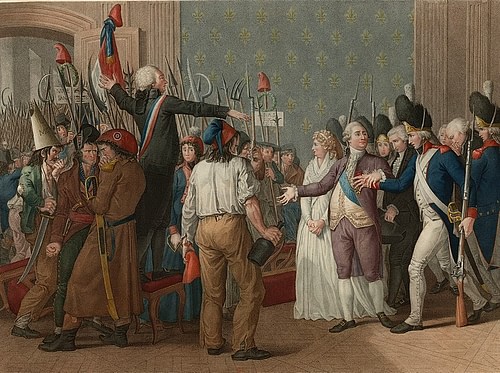
The Demonstration of 20 June 1792 was a final attempt by the sans-culottes of Paris to reconcile King Louis XVI of France (r. 1774-1792) with the French Revolution (1789-99). Prompted by the king's veto of popular decrees, the people invaded the Tuileries Palace and accosted Louis XVI, who greeted them graciously but stood firm in his decisions.
Louis XVI earned his people's wrath by his refusal to adhere to the Legislative Assembly's rulings, as well as a general suspicion that he was apathetic to the defense of France. French military defeats in the early weeks of the War of the First Coalition (1792-97) against Austria made the public anxious, something that inflammatory journalists and politicians took advantage of by whipping the public up and arming them with pikes.
The Demonstration of 20 June was the last peaceful attempt by the Parisian lower classes to turn Louis XVI into a more attentive ruler who listened to the desires of his people. His failure to adhere to them would be fatal. The demonstration significantly removed any aura of majesty that remained of the French monarchy and thereby made possible the Storming of the Tuileries Palace less than two months later, the bloody event that finally ended the monarchy.
A Faltering Crusade
The origins of the Demonstration of 20 June can be found in France's declaration of war on Austria, which occurred exactly two months earlier. Standing before the Legislative Assembly, Louis XVI himself had read out the declaration, to the delirious applause of the gathered deputies. Aside from a few outliers like Maximilien Robespierre (1758-1794), it seemed as if everyone wanted war.
The rising Girondin faction wanted it to ensure their own dominance and to spread the principles of the French Revolution to all the peoples of Europe; a 'universal crusade', in the words of their leader Jacques-Pierre Brissot. On the opposite side of the political spectrum, the Feuillants, the constitutional monarchist faction, wanted war to regain influence for themselves through battlefield victory, which would allow them to wrest power from the radical Girondins and Jacobins. Even Louis XVI wanted war, believing that a victorious Austrian army could rescue him from his virtual imprisonment by the revolutionaries, and restore to him his erstwhile authority.
Yet, the king appeared to harbor second thoughts, as he spent the days following the declaration enveloped in one of his periodic bouts of gloom. His wife, Marie Antoinette (1755-1793) was more proactive. In coded letters to her contacts in Austria, she revealed French military secrets and troop movements. She told the Austrians that the French armies were undersupplied, divided in loyalties, and had been commanded by the Girondin ministry to go on the offensive. They would be easy pickings for the professional armies of her nephew, Francis II, Holy Roman Emperor (r. 1792-1806) and Emperor of Austria (1804-1835).
And indeed, in the first weeks of war, it certainly seemed that way. The French forces were split into three separate armies with a combined total of 150,000 men. They were commanded by three generals who had made their reputations fighting the wars of the Ancien Régime: the north was commanded by the comte de Rochambeau, victor of Yorktown; the army of the center by Gilbert du Motier, marquis de Lafayette, dubbed the 'hero of two worlds'; the army of the south by Nicolas Luckner. They presided over disorganized, undisciplined blobs of men, corrupted by the influence of the anti-aristocratic Jacobins. Moreover, the generals lacked experienced officers, as around half of France's officers had fled the country to join up with its counter-revolutionary enemies.
Consequently, in the first weeks of war, the resolve of France's citizen armies crumbled under the slightest pressure. Almost immediately, several French regiments, including the now infamous Royal German regiment, deserted and went over to the Austrians. A skirmish on 29 April resulted in the total rout of a French force under Irish-born general Théobald Dillon. The French retreated to Lille, where they famously butchered Dillon, having blamed their defeat on him being a spy. They bayoneted him to death in the middle of town before mutilating and burning his body.
Naturally, Dillon's murder made the other French generals anxious, with some, notably Rochambeau, quickly resigning their commands. Others, such as Lafayette, were not about to give up so easily. Once the darling hero of the French people, Lafayette had recently found himself disgraced after the Champ de Mars Massacre the previous summer, when National Guardsmen under his command opened fire on republican demonstrators. Lafayette blamed the Jacobins and other extremist groups for the massacre, as well as for corrupting the Revolution and infiltrating the military. He attributed General Dillon's murder to the natural consequence of Jacobin rhetoric and was concerned something similar may happen in Paris.
Early in May, with the war only a few weeks old, Lafayette wrote to Austrian ambassador Count Mercy d'Argenteau, proposing a ceasefire so he could turn his army around and march on Paris to eradicate the Jacobin threat. The Austrians were evasive in their reply, but the French commanders came together and decided to suspend hostilities on 18 May; Austria was perfectly fine with this, as it gave their ally Prussia more time to mobilize and join the war.
In the meantime, Lafayette's enemies were not as oblivious as he may have hoped, and many felt threatened by this ceasefire. Lafayette and other aristocratic officers were denounced by Robespierre, leader of the Jacobins. "I do not trust the generals," he sneered. "Most of them are nostalgic for the old order" (Schama, 601). With tensions so high, each faction saw the others as France's true enemies, even as Austrian armies were closing in. For a brief moment in time, it must have appeared that war had indeed been a mistake. Marie Antoinette, for one, could not have been happier.
Rise of the Sans-Culottes
In Paris, meanwhile, a new political force was on the rise, a force that had been ever-present but had rarely influenced events since the Storming of the Bastille in 1789. Sans-culottes (literally, without silk breeches) is the name often ascribed to the poor, working-class participants in the Revolution. The word sans-culotte itself, which came into vogue around this time, was meant as an antithesis to the now derogatory term 'aristocrat'; the implication was that it was virtuous to not own such an aristocratic item of clothing as culottes. (Somewhat ironically, Robespierre, who would later take on the role of the sans-culottes' effective spokesman, was himself fond of wearing culottes).
Parisian sans-culottes were restless in the spring of 1792. The previous harvest had been decent, but food was still scarce, in part due to the recent slave uprisings in the French colony of Saint-Domingue (the start of the Haitian Revolution). The quickly depreciating value of the assignat currency only made matters worse. Moreover, reports from the frontier were certainly troubling, especially for a people who had feared foreign invasion for so long.
As apprehension grew, in came the inflammatory journalists who were drawn to such uneasiness as moths to a flame. They had been quiet for the last few months, driven away in the aftermath of the Champ de Mars Massacre, but the absence of their Feuillant enemies from Paris gave them renewed confidence. Jean-Paul Marat, whose propensity for hiding in sewers had given him a nasty skin condition, made attacks against the royal court, which he not-so-incorrectly accused of sabotaging the war effort. More novel attacks were made against the rich, specifically the bourgeoisie, who Marat claimed had abandoned the people. Jacques-René Hébert joined in the lambasting of the king, who he referred to as "Louis le Faux" and called for the distribution of arms to the people so they could defend themselves. "To your pikes, good sans-culottes," wrote Hébert, "sharpen them up to exterminate aristocrats" (Schama, 604).
These journalists, as well as goading from the radical Cordeliers Club, riled up the Parisian commoners. To distinguish themselves as true patriots, they began to wear the red Phrygian caps that had become associated with liberty. They demanded pikes, which had become a symbol of protest; one of the 48 sections of Paris even renamed itself Les Piques. Paris' mayor, Jérôme Pétion, approved their distribution, fearful of an attack against his Girondin allies. By early summer 1792, the sans-culottes were primed for a demonstration of some sort and only needed an excuse. It would soon be inadvertently given to them by the hapless monarch Louis XVI.
The Hated Veto
The story of how Louis XVI incurred the wrath of Paris was one as old as the Revolution itself: he refused to consent to popular decrees. On 27 May, the Legislative Assembly passed a decree for the deportation of refractory priests, who were Catholic clergymen who had stayed loyal to the pope and refused to swear oaths of loyalty to the state, as required by the 1790 Civil Constitution of the Clergy. Although these priests had long been viewed with suspicion by the patriotic revolutionaries, it is possible that Brissot and his allies deliberately passed this decree to provoke the king, as it was an open secret that he sympathized with the refractory priests.
Two days later, the Assembly decided to dissolve the king's Constitutional Guard, a 6,000-man bodyguard created the previous September. Stationed at the Tuileries, the Guard had been proposed by Antoine Barnave as a method to protect the crown against popular insurrection; its disbandment is, therefore, quite telling. A third decree was passed on 8 June which called for the establishment of a camp for 20,000 semi-military provincial volunteers known as fédérés. Brissot and his Girondins claimed that such a force was necessary to protect Paris in case the Austrians broke through; his political opponents, the Feuillants, claimed that this was a Jacobin plot to kidnap the king and hold him for ransom.
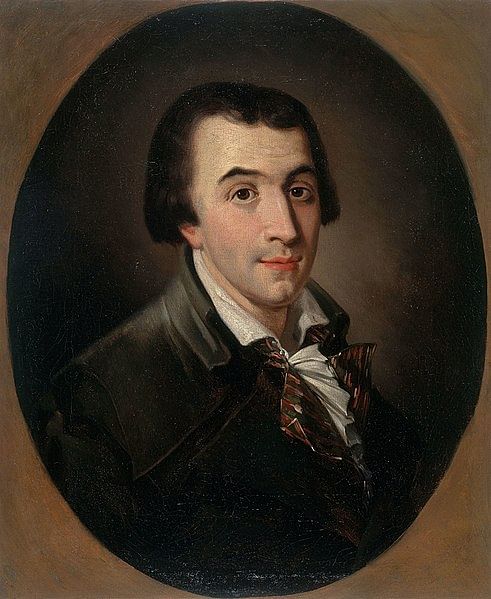
On 11 June, Louis XVI consented to the disbanding of his Constitutional Guard but vetoed the other two decrees. This alarmed the Girondins, who controlled the royal ministry since before the war. Jean-Marie Roland, the king's Minister of the Interior, sent him a letter of protest that had probably been written by his wife, the politically active Girondist Madame Roland (1754-1793). Whichever Roland wrote the letter, it chastised the king for using the veto, claiming that:
This is not the time to retreat or to temporize. The revolution has been made in people’s minds; it will be accomplished and cemented at the cost of bloodshed unless wisdom forestalls evils which it is still possible to avoid…I know that the austere language of truth is rarely welcomed near the throne but I also know that it is because it is so rarely heard that revolutions become necessary. (Schama, 605)
Perhaps it was this insolently worded letter that made Louis XVI dismiss the entire Girondin ministry two days later. Combined with the two vetoes, this insult to the popular Girondins was too much for the people to take. A demonstration was soon planned for 20 June, the anniversary of both the Tennis Court Oath and the king's ill-fated flight to Varennes. Although it is unknown exactly who planned it, it soon became clear that preparations were being made in the Jacobin Club, and by the 16th, practically everyone in Paris knew that something was coming.
The Demonstration
On 20 June, the demonstration was mobilized in each of Paris' sections by various leaders of the sans-culottes: there was the publicist Fournier 'the American', the brewer Santerre, and Theroigne de Mericourt, a leader of the women's republican movement. Although these leaders were by no means the poorest of society, they were significantly not bourgeoisie, marking a turning point in the Revolution.
At 1:30 in the afternoon, 10,000 people were gathered outside Le Manège, the meeting place of the Assembly. They demanded to be let in so they could present a petition. Seeing as the demonstrators were armed with pikes, the deputies were understandably reluctant to admit them but still agreed to let a small delegation of sans-culottes inside. The crowd refused, demanding that all of them be let in to hold a parade throughout the building. The deputies relented. The parade went on for hours, and many of the participants became drunk.

As the festivities continued, the crowd grew larger, surrounding Le Manège and the perimeter of the Tuileries Palace beside it. The gates to the palace grounds were neither guarded nor locked; it was only a matter of time before the sans-culottes poured inside. Fearing bloodshed, the king's guards made no attempt to stop the crowd from entering the palace itself, a decision that baffled a young Napoleon Bonaparte, who apparently witnessed the event. "What madness," he reportedly remarked to a friend. "How could they allow that rabble to enter? Why do they not sweep away four or five hundred of them with cannon? The rest would take themselves off very quickly" (Roberts, 39).
The demonstrators found the king in the Salon de l'Oeil de Boeuf, accompanied only by some attendants and just a handful of guards. For the next two hours, they accosted him, showering him with threats and insults, waving pistols and knives in his face. One protestor even carried a cow's heart skewered atop a pike, meant to represent "the heart of an aristocrat," while another carried a blood-stained doll labelled "Marie Antoinette at the lantern" (the usual way for Parisian sans-culottes to dispose of their enemies was to hang them from lampposts). They harangued him, shouting "tremble, tyrant!" and lambasted his power of the veto (Fraser, 368). One demonstrator even addressed him as "monsieur" rather than "Your Majesty," a breach in protocol that seemed to surprise the king more than any of the threats.
Yet the king showed tremendous composure before this threatening crowd. Refusing to be intimidated, he happily drank a toast to the people and the nation, swearing to uphold the constitution. He was presented with a red liberty cap, which he dutifully wore. Royalists would later refer to this as Louis XVI's greatest moment of humiliation, his 'crown of thorns'; yet the case could be made that this was Louis XVI's finest moment as king. All his reign, he had been indecisive and graceless, seemingly aloof from the needs and desires of his people; now, he talked with them man to man, if only for a few hours. In the past, he had caved to all pressures; now he stood his ground. It was this rare show of resolve by the king that likely averted bloodshed that day. To show that he was not frightened by the crowd, he put the hand of one of his grenadiers over his heart, saying, "See? It does not palpitate" (Schama, 607).

At 6 pm, Mayor Pétion finally made his way to the palace, apologizing to the king and claiming he had just heard what was transpiring. To this obvious lie, Louis replied: "that is astonishing, since this has been continuing for some hours" (Schama, 609). The people planted a liberty tree on the palace grounds and were cleared out by 8 pm, and Louis was able to reunite with Marie Antoinette and his children.
Aftermath
When he heard what happened to the king, Lafayette was livid. It was clear that he had to do something, lest the monarchists lose control of the Revolution forever. He rushed back to Paris and appeared before the Assembly on 28 June, where he was met with applause. He blamed the Jacobins for the attack and demanded their immediate dissolution. This proposal was denied but so was a follow-up motion reproving his conduct.
Not to be defeated, Lafayette went to his old command, the Parisian National Guard. For a time, it looked as though Robespierre's fears would be realized, that Lafayette would finally take control of the government in a coup d'état. But it was not to be. Lafayette did not have the support or influence that Napoleon would later enjoy in his successful Coup of 18 Brumaire. Indeed, Lafayette failed to win the support of the National Guard and even of the royal family, who he was there to save. Marie Antoinette in particular loathed the general and doubted his intentions. "I see well that Monsieur de Lafayette wants to save us," she said, "but who will save us from Monsieur de Lafayette?" (Davidson, 93)
Spurned and humiliated, Lafayette returned to his military post in Alsace. His desperate attempt to gain control in Paris would be his final performance in the French Revolution. He tried again to convince his army to march on the capital, but his men refused. Perhaps remembering the fate of General Dillon, he fled France after the fall of the monarchy on 10 August. Shortly thereafter, he was arrested in the Austrian Netherlands and kept as a prisoner for most of the remainder of the Revolution.
As for the royal family, the Demonstration of 20 June truly marked the beginning of the end. The demonstration failed to achieve its immediate goals, as Louis XVI did not retract his vetoes or reinstate the Girondin ministers. But it did show the power of the sans-culottes and the frailty of the monarchy. Although this time the people of Paris came in peace, next time they would not. The Storming of the Tuileries Palace, which occurred on 10 August, would culminate in a bloody battle between angry Parisians and the king's Swiss Guard. It would also see the destruction of the monarchy and set France on the road to the birth of its first republic.




